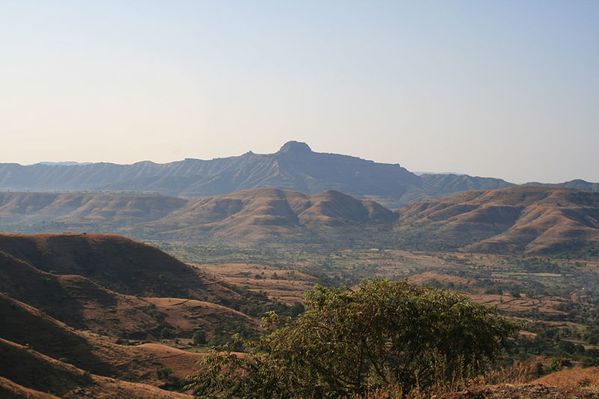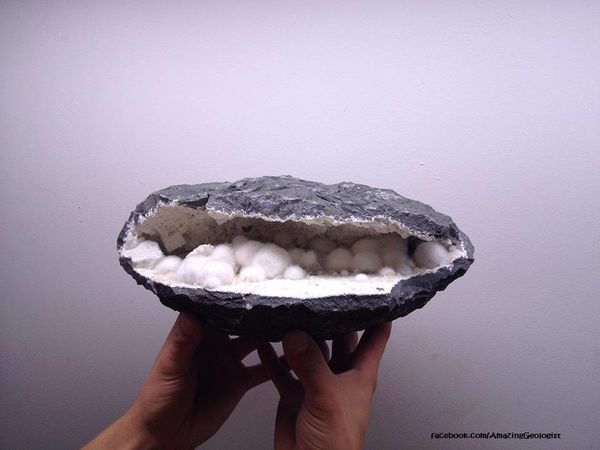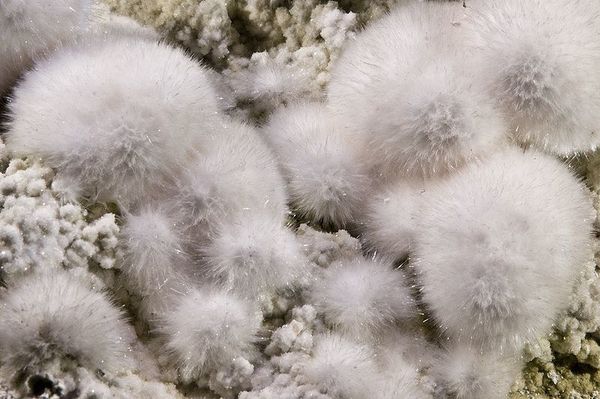Actualité volcanique, Articles de fond sur étude de volcan, tectonique, récits et photos de voyage
A small white ball of flexible needle-like crystals , associated with zeolites , which appears as a contact mineral in basalts ... a hydrated calcium silicate : the
okénite .
 In
the center, Okénite on gyrolite - Origin: Mumbai / India - Photo Kluka
In
the center, Okénite on gyrolite - Origin: Mumbai / India - Photo Kluka
These white crystals of formula
Ca10Si18O46.18H2O are extremely fragile and the slightest touch leaves traces .
They are found mainly in Pune (or
Poona ) in India in the Deccan Traps ( 60-68 Ma) , also in Greenland ( Disko island ), Chile and Ireland.
 Deccan Trapps - view of the stack of lava flows near Pune / India - Photo Kppethe
.
Deccan Trapps - view of the stack of lava flows near Pune / India - Photo Kppethe
.
The first description was made in a discovery in 1828 on the Greenlandic Disko Island and its name, " ockenite " later turned into okénite , honors a German biologist Lorenz
Ocken .
The most attractive specimens are
accompanied by rare minerals such as gyrolite or apophyllite , the phillosilicates .
Some volcanic vesicles (
bubbles in the basalt) are lined with delicate tufts of okenite , and are called geodes of okénite .
Ultra sensitive , never to be touched , they are difficult to conservation
.
 Okenite geode in basalt -
Photo Amazing Geologist
Okenite geode in basalt -
Photo Amazing Geologist
 Geode in basalt containing Okenite -
Origin: Khandivali , Maharashtra , India ( 28 × 22 cm) - Photo Didier Descouens
Geode in basalt containing Okenite -
Origin: Khandivali , Maharashtra , India ( 28 × 22 cm) - Photo Didier Descouens
 Okenite
- enlargement of the central part of the geode / photo above - Origin: Khandivali , Maharashtra, India ( 28 × 22 cm) - Photo Didier Descouens
Okenite
- enlargement of the central part of the geode / photo above - Origin: Khandivali , Maharashtra, India ( 28 × 22 cm) - Photo Didier Descouens
Geodes , from the Greek γεώδης - ge- odes, like land , can form in any type of rock or mineral , but out of habit , the term is usually reserved for training in sedimentary,
vein, magmatic and volcanic rocks.
The formation of geodes in volcanic rocks :
Between 800 ° C and 1200 ° C , molten lava
dissolved volatile components of the rock and produces gas bubbles. As the gas bubbles are
moving in the heart of the lava , they migrate to the surface and can come together to form pockets of larger and larger . Cooling lava, synchronous of the process, latter freezes the
gas bubbles from a certain threshold of viscosity. They shall keep a lens shape.

Geode - ulaval.ca scheme
During cooling of the liquid , the gas bubbles are
transported in the direction of flow of lava . Time factors and management of the flow during his cooling
characterize the shape lens that takes the bubbles. These lenses are like
drops, thin spikes facing upstream of the flow.
The observation of geodes in a lava flow allows to assess with some precision the direction of flow , the origin and rate of cooling temperature and the nature of any obstacles destroyed
by the furnace of lava that can be trapped in the geodes .
A second cooling
then takes place gas this time, from 400 °C, depending on the composition of the gas trapped in the cavity so formed. This gas then passes into aqueous phase and hydrothermal phenomena can begin. The first ( and sometimes only ) crystallization may therefore be
entirely internal to the geode , without external input .
Then, the transformations can continue millions of years , it is also the paradoxical aspect of geodes that being a part of the minerals with rare live yet mineral inputs that may exist millions
of years while constantly evolving while keeping a permanent form of
their original heritage. (wikipedia)
For volcanophilatélistes , there is little stamps on the theme of the geode
... a stamp of French Territory of the
Afars and Issas (Somali coast, Djibouti ) of 1971 shown a volcanic geode.

Sources :
- Géowiki - Okénite
- Mindat - Okénite - fiche & photos
- Webmineral - Okénite
- Mineralogical magazine - Zeolites and associated secondary minerals in the Deccan traps of western India - by R.N.Sukheswala & al. - link
Thème Magazine - Hébergé par Overblog


